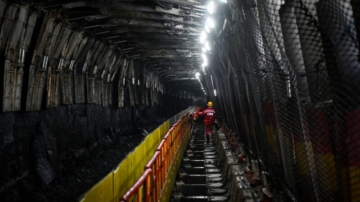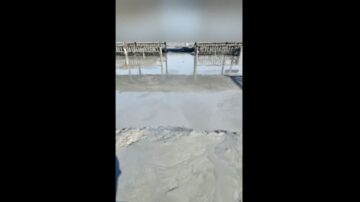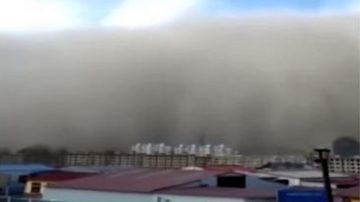【新唐人2014年08月04日讯】在大陆南方多省经历严重洪涝灾害的同时,河南、河北等12个省份则正在经历几十年未见的严重旱灾,部份地区已断水3个月。专家分析,多年来大陆当局片面追求经济高速增长,水资源等自然环境被严重破坏,从“三峡大坝”到“南水北调”,无一不给周边生态带来巨大的负面影响。
今年入夏以来,河南、河北、山西、陕西、湖北、内蒙、新疆等12省区持续高温少雨,出现了几十年未见的旱灾。其中,陕西遭遇53年来最严重干旱,河南省则遭遇63年来的最严重干旱,部份地区已断水3个月。
大陆媒体报导,截至7月30号,12省区作物受旱面积超过了7,200万亩,受影响牲畜达207万头。超过160万人因旱情导致饮水困难。旱情主要集中在河南平顶山、洛阳、漯河、许昌、焦作、河北廊坊、沧州、保定、唐山、陕西渭南等地,其中河南为本次旱灾的重灾区,受灾面积将近全国受灾面积的一半。
河南宝丰大营镇杜先生:“一直都没有下雨。庄稼都旱死完了。连家里的饮用水都是用桶拉着、从几十里外买着吃的。”
河南宝丰大营镇杜先生表示,虽然旱情严重,老百姓的生活很困难,但当地政府并没有任何作为,对灾情无人问津。
在西安郊区的一位赵姓农民也向《新唐人》介绍了当地的旱情,他还披露当地水利设施被破坏的隐情。
西安郊区农民赵先生:“庄稼都枯死了。很早以前,我们村集体的水利设施、深井都被人为破坏了,破坏了之后,农民种甚么东西都是绝收。”
这名赵姓农民表示,当地村干部故意人为将水利设施破坏,迫使农民无法耕种,然后他们再把土地变相倒卖、谋取私利。村民上告无门,非常无奈。
据了解,青藏高原是中国一些重要河流的发源地,但是十多年来的西部大开发,使很多草原受到破坏、土地受到污染,“青藏高原”上已经出现河床干涸的现象。在中国其它地区也出现类似的问题,比如东北的湿地正被建筑业所吞噬。
《美国之音》中文网报导,7月18号美国“塔夫茨大学”中国外交关系副教授萨勒曼汗(Sulmaan Khan)在美国《外交事务》杂志上撰文指出,中国公众已经对城市开发,带来的水资源匮乏、饮用水、土壤受到污染这类问题,感到非常不满。当局如果不尽快处理水危机,不仅将导致对生态环境的严重破坏,更会带来“慢性自杀”似的灾难。
文章谈到,中共当局力推的“南水北调”工程将给生态环境带来很大危险。这个浩大工程会阻断河流系统,引发土壤流失,反而会加剧水资源的缺乏。但当局至今仍然没有把保护水资源提到议事日程上来。
中国金融智库研究员巩胜利:“南水北调、三峡建设,还有当年苏联帮助建设的黄河三门峡电站,都是这种结果。这为后人留下了一个难以解决的灾难。”
在此之前,外界曾分析指出,近年来重庆、四川等地接连发生多起地震、泥石流等灾害,这在很大程度上,和“三峡大坝”建成之后,对周边生态环境的破坏有关。
而大陆媒体报导,8月2号至4号,四川盆地、重庆、陕西、山西、河南、湖北等地部份地区最高气温可达摄氏37到39度,局部可达40度以上。
7月30号,河南省水文资源局对平顶山、南阳、信阳发布了枯水预警,预计未来一周仍无有效降雨。而8月中旬前,陕西大部份地区,也持续高温少雨,旱情将更加严重。
采访/朱智善 编辑/李谦 后制/萧宇
12Provinces Suffer from Severe Drought
While the south is experiencing severe floods, severest drought
in decades is hitting 12 provinces in China such as Henan,
Hebei and others.
Some areas have been without water for three months.
Experts analyze water and ecology are destroyed at the cost
of rapid economic growth.
Projects such as the Three Gorges Dam and the Water Diversion
are causing huge negative impact to the surrounding ecology.
Severest drought in decades has occurred in 12 provinces
such as Henan, Hebei, Shanxi, Shaanxi, Hubei, Inner Mongolia,
Xinjiang and others the summer of this year.
For instance, Shaanxi suffered its worst drought in 53 years,
Henan suffered the worst one in 63 years.
Some areas have been without water for three months.
Mainland media reported that as of July 30, drought covers
more than 11.9 million acres of farm land,
affecting 2.07 million farm animals.
More than 1.6 million people lack drinking water.
Drought mainly centers in Henan province, accounting for half
of the drought stricken area in the entire nation.
Mr. Du, a resident of Henan: "There has been no rain. All the
crops were dry dead. We have to get drinking water in pails
from tens of miles away, as well as food."
Mr. Du indicates the local government has done nothing to the
disaster despite the severity of the drought and the hardship.
A peasant of Xi'an, Shaanxi province, Mr. Zhao, told NTD TV
about the local drought.
He also revealed that local reservoirs
were deliberately destroyed.
Mr. Zhao: "The crops have withered. The reservoirs and the
wells were ruined intentionally long ago.
Since then, there has been no harvest."
Mr. Zhao explains, since local leaders deliberately
destroyed the irrigation facilities, farming was forced to stop.
The deserted land was then resold and became personal gain
for the village leaders. Villagers were left with nothing.
The Tibetan Plateau, the birthplace of some of China's major
rivers, suffers severe damage and pollution after dozens of
years of exploitation in the west.
Dry riverbeds are widespread in the Plateau.
Similar issues have also occurred to many other areas in China,
such as the northeast wetlands being swallowed up
by real estate development.
Sulmaan Khan, assistant Professor of Chinese
Foreign Relations at Tufts University, described in an article in
Foreign Affairs magazine, "The Chinese public is tired of the
water shortages, unsafe drinking water, and soil contamination
caused by haphazard urban development."
The water shortage is not only a serious damage to the ecology,
but also suicidal.
The article mentioned the water diversion project brings
immense ecological risks.
"It is quite possible that the project will disrupt the river
systems and exacerbate water shortages, rather than solve them,
by triggering soil erosion."
But, Beijing has yet to develop a plan that addresses the entirety
of its environmental woes.
Chinese financial think tank researcher Gong Shengli:
"The water diversion and the Three Gorges dam, as well as the
Sanmenxia power plants built by the Soviet Union,
have resulted in disasters hard to resolve."
Many seismic activities and mud slides in surrounding areas
such as Chongqing, Sichuan and so forth, have been analyzed
to be greatly connected to ecological damage brought
by the Three Gorges Dam.
Temperatures between August 2 and 4 reached as high as
37 to 39 degrees C, and even 40 degrees in the Sichuan Basin,
Chongqing, Shaanxi, Shanxi, Henan, and Hubei.
July 30, Hydrology and Resources Bureau of Henan Province
issued a drought warning: No rainfall is expected next week.
And by mid-August, most parts of Shaanxi will continue under
high temperatures and little rain, the drought will worsen.
Interview/Zu Zhishan Edit/LiQian Post-Production/XiaoYu
今年入夏以来,河南、河北、山西、陕西、湖北、内蒙、新疆等12省区持续高温少雨,出现了几十年未见的旱灾。其中,陕西遭遇53年来最严重干旱,河南省则遭遇63年来的最严重干旱,部份地区已断水3个月。
大陆媒体报导,截至7月30号,12省区作物受旱面积超过了7,200万亩,受影响牲畜达207万头。超过160万人因旱情导致饮水困难。旱情主要集中在河南平顶山、洛阳、漯河、许昌、焦作、河北廊坊、沧州、保定、唐山、陕西渭南等地,其中河南为本次旱灾的重灾区,受灾面积将近全国受灾面积的一半。
河南宝丰大营镇杜先生:“一直都没有下雨。庄稼都旱死完了。连家里的饮用水都是用桶拉着、从几十里外买着吃的。”
河南宝丰大营镇杜先生表示,虽然旱情严重,老百姓的生活很困难,但当地政府并没有任何作为,对灾情无人问津。
在西安郊区的一位赵姓农民也向《新唐人》介绍了当地的旱情,他还披露当地水利设施被破坏的隐情。
西安郊区农民赵先生:“庄稼都枯死了。很早以前,我们村集体的水利设施、深井都被人为破坏了,破坏了之后,农民种甚么东西都是绝收。”
这名赵姓农民表示,当地村干部故意人为将水利设施破坏,迫使农民无法耕种,然后他们再把土地变相倒卖、谋取私利。村民上告无门,非常无奈。
据了解,青藏高原是中国一些重要河流的发源地,但是十多年来的西部大开发,使很多草原受到破坏、土地受到污染,“青藏高原”上已经出现河床干涸的现象。在中国其它地区也出现类似的问题,比如东北的湿地正被建筑业所吞噬。
《美国之音》中文网报导,7月18号美国“塔夫茨大学”中国外交关系副教授萨勒曼汗(Sulmaan Khan)在美国《外交事务》杂志上撰文指出,中国公众已经对城市开发,带来的水资源匮乏、饮用水、土壤受到污染这类问题,感到非常不满。当局如果不尽快处理水危机,不仅将导致对生态环境的严重破坏,更会带来“慢性自杀”似的灾难。
文章谈到,中共当局力推的“南水北调”工程将给生态环境带来很大危险。这个浩大工程会阻断河流系统,引发土壤流失,反而会加剧水资源的缺乏。但当局至今仍然没有把保护水资源提到议事日程上来。
中国金融智库研究员巩胜利:“南水北调、三峡建设,还有当年苏联帮助建设的黄河三门峡电站,都是这种结果。这为后人留下了一个难以解决的灾难。”
在此之前,外界曾分析指出,近年来重庆、四川等地接连发生多起地震、泥石流等灾害,这在很大程度上,和“三峡大坝”建成之后,对周边生态环境的破坏有关。
而大陆媒体报导,8月2号至4号,四川盆地、重庆、陕西、山西、河南、湖北等地部份地区最高气温可达摄氏37到39度,局部可达40度以上。
7月30号,河南省水文资源局对平顶山、南阳、信阳发布了枯水预警,预计未来一周仍无有效降雨。而8月中旬前,陕西大部份地区,也持续高温少雨,旱情将更加严重。
采访/朱智善 编辑/李谦 后制/萧宇
12Provinces Suffer from Severe Drought
While the south is experiencing severe floods, severest drought
in decades is hitting 12 provinces in China such as Henan,
Hebei and others.
Some areas have been without water for three months.
Experts analyze water and ecology are destroyed at the cost
of rapid economic growth.
Projects such as the Three Gorges Dam and the Water Diversion
are causing huge negative impact to the surrounding ecology.
Severest drought in decades has occurred in 12 provinces
such as Henan, Hebei, Shanxi, Shaanxi, Hubei, Inner Mongolia,
Xinjiang and others the summer of this year.
For instance, Shaanxi suffered its worst drought in 53 years,
Henan suffered the worst one in 63 years.
Some areas have been without water for three months.
Mainland media reported that as of July 30, drought covers
more than 11.9 million acres of farm land,
affecting 2.07 million farm animals.
More than 1.6 million people lack drinking water.
Drought mainly centers in Henan province, accounting for half
of the drought stricken area in the entire nation.
Mr. Du, a resident of Henan: "There has been no rain. All the
crops were dry dead. We have to get drinking water in pails
from tens of miles away, as well as food."
Mr. Du indicates the local government has done nothing to the
disaster despite the severity of the drought and the hardship.
A peasant of Xi'an, Shaanxi province, Mr. Zhao, told NTD TV
about the local drought.
He also revealed that local reservoirs
were deliberately destroyed.
Mr. Zhao: "The crops have withered. The reservoirs and the
wells were ruined intentionally long ago.
Since then, there has been no harvest."
Mr. Zhao explains, since local leaders deliberately
destroyed the irrigation facilities, farming was forced to stop.
The deserted land was then resold and became personal gain
for the village leaders. Villagers were left with nothing.
The Tibetan Plateau, the birthplace of some of China's major
rivers, suffers severe damage and pollution after dozens of
years of exploitation in the west.
Dry riverbeds are widespread in the Plateau.
Similar issues have also occurred to many other areas in China,
such as the northeast wetlands being swallowed up
by real estate development.
Sulmaan Khan, assistant Professor of Chinese
Foreign Relations at Tufts University, described in an article in
Foreign Affairs magazine, "The Chinese public is tired of the
water shortages, unsafe drinking water, and soil contamination
caused by haphazard urban development."
The water shortage is not only a serious damage to the ecology,
but also suicidal.
The article mentioned the water diversion project brings
immense ecological risks.
"It is quite possible that the project will disrupt the river
systems and exacerbate water shortages, rather than solve them,
by triggering soil erosion."
But, Beijing has yet to develop a plan that addresses the entirety
of its environmental woes.
Chinese financial think tank researcher Gong Shengli:
"The water diversion and the Three Gorges dam, as well as the
Sanmenxia power plants built by the Soviet Union,
have resulted in disasters hard to resolve."
Many seismic activities and mud slides in surrounding areas
such as Chongqing, Sichuan and so forth, have been analyzed
to be greatly connected to ecological damage brought
by the Three Gorges Dam.
Temperatures between August 2 and 4 reached as high as
37 to 39 degrees C, and even 40 degrees in the Sichuan Basin,
Chongqing, Shaanxi, Shanxi, Henan, and Hubei.
July 30, Hydrology and Resources Bureau of Henan Province
issued a drought warning: No rainfall is expected next week.
And by mid-August, most parts of Shaanxi will continue under
high temperatures and little rain, the drought will worsen.
Interview/Zu Zhishan Edit/LiQian Post-Production/XiaoYu








